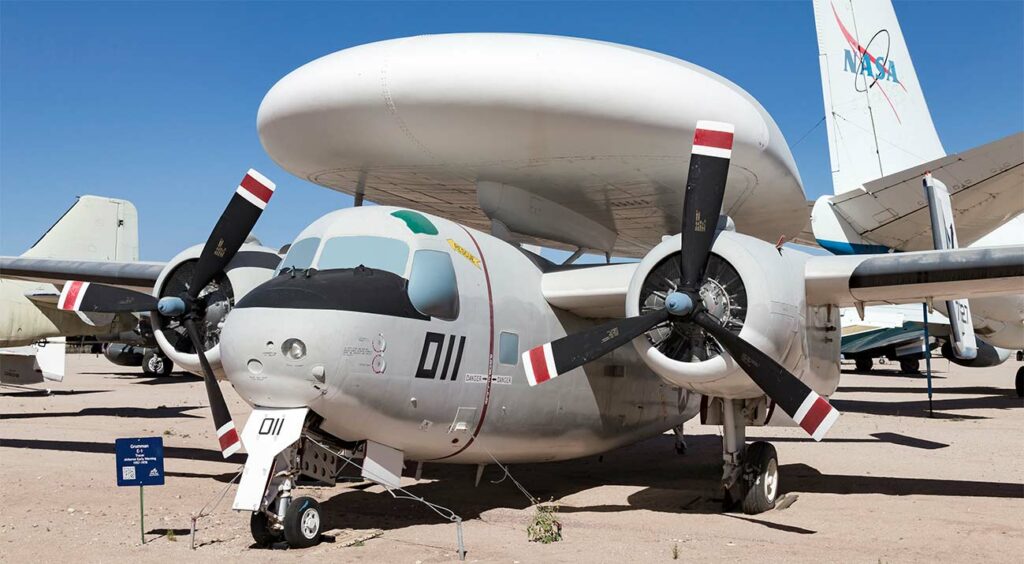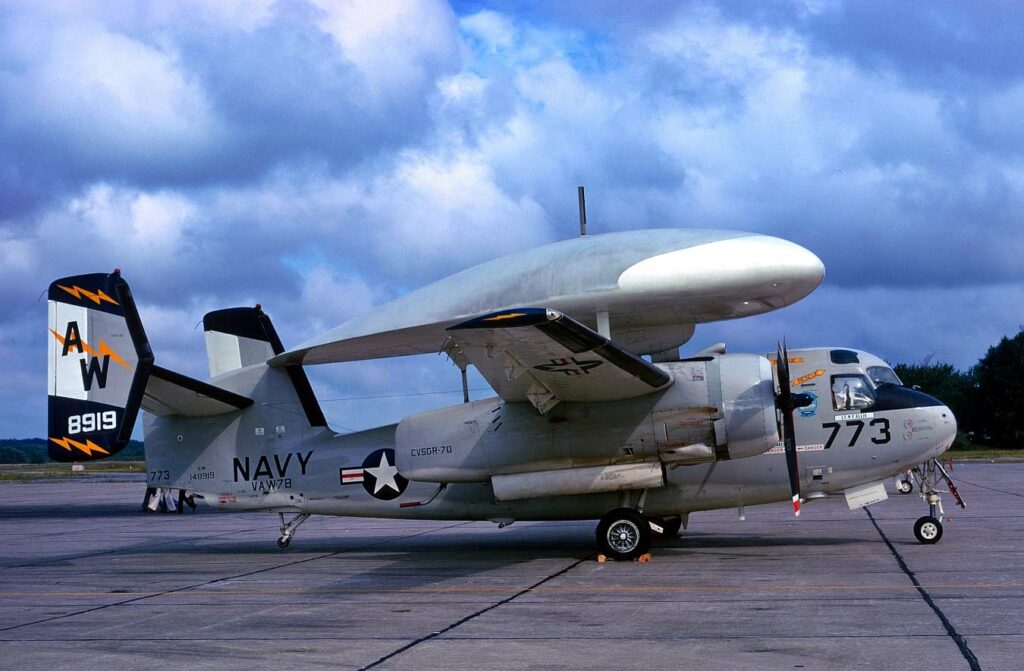The Grumman E-1 Tracer, the first purpose-built airborne early warning aircraft used by the US Navy.
In Brief
The Grumman E-1 Tracer, originally designated WF-2, is a landmark aircraft in naval aviation history, serving as the United States Navy’s first carrier-based airborne early warning (AEW) platform. Introduced in the 1950s, it was developed from the Grumman C-1 Trader cargo aircraft, featuring a distinctive large radome above its fuselage. The E-1 Tracer was powered by two Wright R-1820-82WA radial engines, each producing 1,525 horsepower, enabling a maximum speed of 256 knots (296 mph, 476 km/h). With a wingspan of 72 feet 4 inches (22.05 meters) and a length of 45 feet 6 inches (13.87 meters), the Tracer could accommodate a crew of four, including the pilot, co-pilot, and radar operators. It was equipped with the AN/APS-82 radar, providing early warning of incoming threats and vectoring interceptor aircraft to targets. Despite its relatively modest speed and range, the E-1 Tracer was a crucial asset for fleet defense, enhancing the Navy’s capability to detect and respond to threats beyond the visual range of surface ships.

History of the Development of the Grumman WF-2 / E-1 Tracer
In the early Cold War era, the United States Navy recognized the need for an advanced airborne early warning (AEW) system to protect carrier battle groups against the Soviet Union’s growing submarine and long-range bomber threats. The concept of using aircraft to extend radar coverage beyond the horizon emerged as a crucial strategy in naval warfare, leading to the development of the Grumman WF-2, later redesignated as the E-1 Tracer.
The program was launched by the US Navy in the early 1950s, with Grumman Aircraft Engineering Corporation tasked with developing an AEW aircraft based on its successful C-1 Trader design. The objective was to create an airborne platform capable of early detection of incoming threats, thereby extending the reaction time for carrier battle groups and enhancing their defensive capabilities.
The E-1 Tracer first flew on 17 December 1956, marking the birth of a new era in naval aviation. Unlike its contemporaries, the Tracer did not have a NATO nickname, as it was specifically designed for the US Navy and primarily served in that capacity. Its development was a response to the strategic demands of the Cold War, providing the US Navy with a significant advantage in maritime surveillance and air defense.
The introduction of the E-1 Tracer represented a significant technological and operational leap forward. As the first purpose-built AEW aircraft, it set the foundation for future developments in airborne early warning and control systems, playing a critical role in the evolution of naval air operations.
Design of the Grumman WF-2 / E-1 Tracer
The Grumman E-1 Tracer was a pioneering design in the field of airborne early warning aircraft. Its most distinguishing feature was the large, radome-mounted atop the fuselage, housing the AN/APS-82 radar system. This radome, measuring approximately 16 feet in diameter, enabled the Tracer to detect and track airborne threats from a considerable distance, providing invaluable early warning to naval forces.
With dimensions including a wingspan of 72 feet 4 inches (22.05 meters) and a length of 45 feet 6 inches (13.87 meters), the Tracer was relatively compact for its role, enabling operations from the decks of aircraft carriers. The aircraft was powered by two Wright R-1820-82WA radial engines, each producing 1,525 horsepower, which provided a balance between performance and reliability.
The design of the E-1 Tracer included several innovations, such as folding wings to save space on aircraft carriers and a tailhook for arrested landings. The aircraft’s design allowed for a crew of four, including two pilots and two radar operators, who managed the sophisticated radar and communications equipment.
Despite its advantages, the E-1 Tracer had limitations, including relatively modest speed and range compared to later AEW aircraft. However, its design represented a significant advancement in naval aviation technology, offering a new level of situational awareness and fleet defense capability.
The E-1 Tracer’s design brought several benefits to naval operations, including the ability to conduct long-duration flights for extended radar coverage, improved coordination between air and surface units, and enhanced capability to direct interceptor aircraft to distant targets. These advantages were crucial in the context of Cold War naval confrontations, where early detection of threats could mean the difference between victory and defeat.
Performance of the Grumman WF-2 / E-1 Tracer
The performance of the Grumman E-1 Tracer was characterized by its capability to fulfill the airborne early warning role effectively, despite the constraints of its era’s technology. With a maximum speed of 256 knots (296 mph, 476 km/h) and a service ceiling of 22,000 feet (6,700 meters), the Tracer was not designed for speed or high-altitude operations but for endurance and radar coverage.
Powered by its two Wright R-1820-82WA radial engines, the E-1 Tracer had a range of approximately 1,000 nautical miles (1,852 kilometers), enabling it to conduct extended patrols around the carrier battle group. This endurance was crucial for maintaining a continuous radar watch, providing early warning of incoming threats and vectoring friendly aircraft to intercept.
When compared to its contemporaries, such as the Lockheed EC-121 Warning Star, the E-1 Tracer was smaller and more suited to carrier operations, although it lacked the higher speed, altitude, and range of the EC-121. Nonetheless, the Tracer’s unique capabilities as a carrier-based AEW platform made it a valuable asset for the US Navy, enhancing the fleet’s overall situational awareness and defensive posture.
The E-1 Tracer’s operational performance demonstrated the importance of airborne early warning in naval warfare, setting the stage for the development of more advanced AEW aircraft. Its ability to extend the radar horizon beyond the range of surface ships significantly improved the Navy’s capability to detect and respond to threats, reinforcing the strategic advantage of carrier battle groups during the Cold War.
Variants of the Grumman WF-2 / E-1 Tracer
The Grumman E-1 Tracer was primarily produced in a single variant, with minor modifications throughout its service life. The initial designation of WF-2 was later changed to E-1B, reflecting the US Navy’s revised naming convention for electronic warfare and airborne early warning aircraft. Although there were no significantly different operational variants, the E-1 Tracer underwent continuous upgrades to its radar and electronic systems to enhance its capabilities and extend its service life.
Despite the lack of multiple variants, the E-1 Tracer’s impact on naval aviation and airborne early warning was profound, laying the groundwork for subsequent AEW aircraft such as the E-2 Hawkeye, which offered greater capabilities and performance.

Military Use and Combat of the Grumman WF-2 / E-1 Tracer
The Grumman E-1 Tracer served with distinction in the US Navy from the late 1950s through the 1970s. As the Navy’s first dedicated AEW aircraft, the Tracer played a critical role in enhancing the fleet’s defensive capabilities, particularly in the context of the Cold War, where the threat of Soviet submarine and air-launched missile attacks was a constant concern.
The E-1 Tracer did not carry armaments, as its primary mission was surveillance, early warning, and command and control. Instead, its value lay in its ability to detect incoming threats at long ranges and vector fighter aircraft to intercept them, significantly improving the fleet’s defensive posture.
Although the Tracer did not see combat in the traditional sense, its presence and capabilities had a strategic impact, deterring potential adversaries and enhancing the effectiveness of carrier strike groups. Its operations during periods of heightened tension, such as the Cuban Missile Crisis, demonstrated the importance of airborne early warning in maintaining situational awareness and readiness.
The E-1 Tracer was eventually replaced by the more advanced E-2 Hawkeye in the 1970s, which offered greater speed, range, and radar capabilities. The transition to the E-2 marked the end of the Tracer’s service life, but its legacy as the US Navy’s first AEW aircraft continues to influence naval aviation.
The Grumman E-1 Tracer, with its distinctive radome and pioneering role in airborne early warning, marked a significant advancement in naval warfare capabilities. Its development, design, and operational service reflect the strategic imperatives of the Cold War era, enhancing the US Navy’s ability to detect and counter threats at sea. Despite its limitations in speed and range, the E-1 Tracer’s contribution to situational awareness and fleet defense set the foundation for future AEW aircraft, underscoring the importance of airborne surveillance in modern naval operations. The legacy of the E-1 Tracer is evident in the continued evolution of AEW platforms, highlighting its enduring impact on military aviation technology and strategy.
Back to the Special Aircraft section